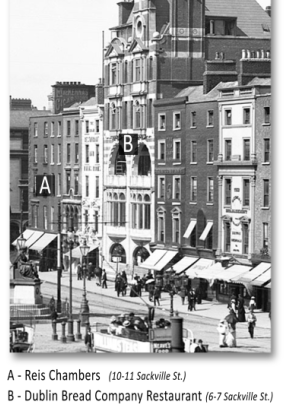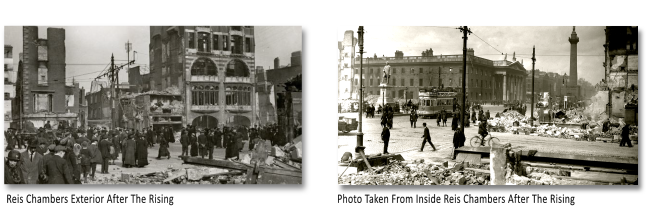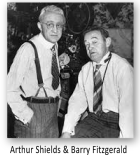The Grand Central Café, on the corner of O’Connell Street and Lower Abbey Street, is one of the most interesting, and often overlooked locations associated with the Easter Rising.
In 1916 the buildings on this site were known as Reis’s Chambers because it was the location of the Charles L. Reis & Co. Jewelers and Fancy Goods warehouse. However the most important business located at this address during the Rising was the Irish School of Wireless, which would play a key role in the events of Easter Week.
In 1916 the buildings on this site were known as Reis’s Chambers because it was the location of the Charles L. Reis & Co. Jewelers and Fancy Goods warehouse. However the most important business located at this address during the Rising was the Irish School of Wireless, which would play a key role in the events of Easter Week.
Using mainly the Bureau of Military History Witness Statements (published online by the Irish Military Archives ) it was possible to piece together the fascinating events that happened on this site. The story of the Irish School of Wireless at Reis’s Chambers was also supplemented by newspaper reports, available online at the Irish News Archive.
The Irish School of Wireless
 According to Thom’s Commercial and Street Directory for Dublin 1916, the following businesses were located at Numbers 10 and 11 Sackville Street (O’Connell Street):
According to Thom’s Commercial and Street Directory for Dublin 1916, the following businesses were located at Numbers 10 and 11 Sackville Street (O’Connell Street):No.10 Reis Chambers,
- Charles L., & Co., (Fancy goods warehouse).
- Boyd, John, (Hairdressing Saloon)
- City of Dublin Collecting Insurance Co., (Manager C.W. Guest).
- Charles L., & Co., (Jewellers, cutters, watch makers, also at No. 10).
- British Legal & United Provident Assurance Co.
- The Foley Typewriter Trading Co.
- Foghladha, Michael, Typewriters & Supplies
- The Irish School of Wireless (late Norton Wireless Schools Ltd. Tuition in all kinds of wireless apparatus. Prop. P.K. Turner)
The Irish School of Wireless was run by P.K. Turner (who later became editor of the highbrow technical journal ‘Experimental Wireless’) and regularly advertised in the national papers telling parents to ‘Send your boys’ to learn on a thoroughly modern apparatus and promised ‘excellent prospects’ for their students.
Wireless Training for Irish Volunteers
Joseph Plunkett, a signatory of the 1916 Proclamation, had a keen interest in wireless technology since his youth. The Plunkett’s estate at Larkfield, was known as the ‘Kimmage Garrison’ and men from Republican organisations in Britain arrived there in the weeks and months leading up to the 1916 Rising. Wireless training for Irish Volunteers was conducted by Fergus O’Kelly, Con Keating and David Bourke (the latter two were qualified Marconi operators) at Larkfield. Con Keating would later be drowned at Ballykissane Pier attempting to capture the wireless station at Valentia Island.
Easter Monday 1916
On Easter Monday, the Kimmage Garrison were mobilised by George Plunkett and made their way to Liberty Hall by tram. Members of the Irish Volunteers, including the Kimmage Garrison, and the Irish Citizen Army marched from Liberty Hall, up Lower Abbey Street and formed up before the General Post Office (GPO) on Sackville Street.
The order was then given to charge and take the post office.
After the insurgents had secured the GPO, Fergus O’Kelly was ordered by Joseph Plunkett to take a detachment of men to Reis’s Chambers. Their orders were to take possession of the building with the aim of getting the wireless transmitter at the Irish School of Wireless working. With the outbreak of the First World War, the British government ordered that all wireless equipment on board merchant vessels be dismantled and all experimental wireless stations be closed. The wireless room at 10 and 11 Sackville Street had been sealed by the British military and the aerials on the roof had been taken down.
The men entered the building from the Lower Abbey Street side and advised the caretaker to leave. They had to re-install the aerials on the roof of the building with wire obtained from the General Electric Co. on Trinity Street. O’Kelly advised headquarters in the GPO that their position at 10 and 11 Sackville Street was vulnerable. A party of men under Captain Weafer were sent to secure other buildings along the rest of the block down to Hopkins and Hopkins at O’Connell Bridge. These included the imposing Dublin Bread Company (DBC) Restaurant in the middle of the block with its commanding domed roof.
On the evening of Monday 24th April 1916, two London Irish Volunteers from the Kimmage Garrison, William (Liam) Daly and John ‘Blimey’ O’Connor were sent by James Connolly to report to Captain Liam Breen, the engineer officer in Reis’s. Both men were electricians. Despite the initial suspicion of these two men because of their Cockney accents they were recognised by Captain Weafer and admitted. The batteries for the wireless transmitters were located on the ground floor and they had to be placed on charge before the transmitters would begin broadcasting. A barricade was placed across Lower Abbey Street made from anything the volunteers could lay their hands on from surrounding warehouses.
The erection of the new aerials by John O’Connor and William Daly was not completed until the following morning. On the roof they were under heavy fire from British snipers. As the men in Reis’s were having difficulty getting the transmitter operational, another electrician, Luke Kennedy, was sent over to help and they were eventually successful.
Tuesday 25th April 1916
After reporting to the GPO that the 1.5 kw transmitter (fitted with a converter and 24 stud discharge inductance tuned to 600 metres) was now in full working order a message was sent from James Connolly for broadcast:'Irish Republic declared today in Dublin. Irish troops have captured city and are in full possession. Enemy cannot move in city.'
The garrison continued to tap out the message hour after hour in the hopes that it would be received. The insurgents hoped that ships around the coast of Ireland and in the Atlantic Ocean would pick up the message and relay it on to America, thereby evading the strict military censorship of the British government. The receiving apparatus at the Irish School of Wireless was not working so there was no way of knowing if their messages were being received.
According to John O’Connor another message was sent by Morse code directly to the telegraph station in Valencia:
'Kathleen was successfully operated on today at 12 O'Clock,'(a prearranged code that the Rising had begun.)
On the afternoon of Tuesday 25th April Captain Liam Tannam was informed by James Connolly to take control of the outpost at Reis’s Chambers as Captain Weafer had been shot and was in the first aid station at the Hibernian Bank, on the opposite side of Lower Abbey Street. The following order was typed up and given to him:
"To the Officer in Charge". Army of the Irish Republic (Dublin Command) Headquarters. Date 25th April 1916. To Officer in Charge Reis's and D.B.C. The main purpose of your post is to protect our wireless station. Its secondary purpose is to observe Lower Abbey Street and Lower O'Connell Street. Commandeer in the D.B.C. whatever food and utensils you require. Make sure of a plentiful supply of water wherever your men are. Break all glass in the windows of the rooms occupied by you for fighting purposes. Establish a connection between your forces in the D.B.C. and Reis's building. Be sure that the stairways leading immediately to your rooms are well barricaded. We have a post in the house at the corner of Bachelor's Walk, in the Metropole Hotel, in the Imperial Hotel, in the General Post Office. The directions from which you are likely to be attacked are from the Custom House, and from the far side of the river, D'Olier Street or Westmoreland Street. We believe there is a sniper in McBirney's on the far side of the river.
Signed. James Connolly.
Wednesday 26th April 1916
On the morning of Wednesday 26th April the considerable stock of food in the neighboring DBC restaurant was liberated and sent over to the commissary in the GPO. Around midday, Captain Weafer was killed by machine gun fire towards the Hibernian Bank. As Liam Tannam had earlier been recalled to the GPO, Captain Liam Breen took over command of the outpost at Reis’s Chambers.
Later that day, signals from the GPO to cease sniping at British positions from the top of the DBC restaurant were misinterpreted as an order to abandon the block. When the garrison arrived at the GPO they were instructed to return. The situation on Sackville Street was deteriorating and the street was now under heavy artillery fire and it was decided to remove the wireless equipment and transfer it to the GPO. The equipment was very heavy and it was quite difficult to manoeuvre it down the narrow stairs of Reis’s Chambers. According to Fergus O’Kelly, it was loaded onto a horse and cart but eventually had to be abandoned as the Volunteers came under heavy gun fire. Two volunteers were seriously wounded at the corner of Abbey Street and Marlboro Street as the party attempted to make their way back to the GPO. However Liam Daly wrote that the equipment was placed on an upturned table and covered with a white sheet. Six men carried the table across to the GPO and as they crossed O’Connell Street there was a ceasefire from the British side. Daly stated that the British probably believed that the Volunteers were transferring a badly wounded man.
Later that day, signals from the GPO to cease sniping at British positions from the top of the DBC restaurant were misinterpreted as an order to abandon the block. When the garrison arrived at the GPO they were instructed to return. The situation on Sackville Street was deteriorating and the street was now under heavy artillery fire and it was decided to remove the wireless equipment and transfer it to the GPO. The equipment was very heavy and it was quite difficult to manoeuvre it down the narrow stairs of Reis’s Chambers. According to Fergus O’Kelly, it was loaded onto a horse and cart but eventually had to be abandoned as the Volunteers came under heavy gun fire. Two volunteers were seriously wounded at the corner of Abbey Street and Marlboro Street as the party attempted to make their way back to the GPO. However Liam Daly wrote that the equipment was placed on an upturned table and covered with a white sheet. Six men carried the table across to the GPO and as they crossed O’Connell Street there was a ceasefire from the British side. Daly stated that the British probably believed that the Volunteers were transferring a badly wounded man.
At 5pm on Wednesday 26th April the leadership in the GPO decided to reoccupy Reis’s and reinforce the DBC Restaurant. It was felt it was necessary to supplement the forces based in the nearby Imperial Hotel to prevent a possible advance of British forces over O’Connell Bridge. Fifteen men volunteered and advanced through North Earl Street and Marlboro Street. Luke Kennedy stated that ‘We dashed across and got into Reis’s and, as I dashed across, I saw four of the men shot down and one seriously wounded.’ During the night the DBC was shelled and caught fire, the following day the top floors of Reis’s collapsed. The nine men in the garrison were still alive though and survived the return to the GPO with only one man wounded. At this point numbers 10 and 11 Sackville Street were abandoned.

Radio and the Rising
In his 1964 book Understanding Media, Marshall McLuhan wrote, ‘The Irish Rebels used a ship’s radio to make, not a point to point message, but a diffused broadcast in hope of getting word to any ship that would relay their story to the American press. This is widely accepted as the world’s first radio broadcast.’ Unfortunately this was not the case as there were several radio stations broadcasting at this stage in the United States. The broadcasts from Reis’s Chambers could be considered the first pirate radio station in the world or possibly the world’s first news broadcast and was the first time insurgents had recognised the importance of broadcasting their message to the wider world.
Arthur Shields
 Among the six men O’Kelly took with him to Reis’s Chambers and the Irish School of Wireless on Easter Monday was Abbey Theatre actor Arthur Sheilds. Born in Portobello to a Protestant family, Arthur’s father (Adolphus Shields) was an active trade unionist, socialist and colleague of James Connolly in the Irish Socialist Republican Party. After the 1914 Howth gun running, Sheilds joined the Irish Volunteers and fought in the GPO as well as numbers 10 and 11 Sackville Street during the 1916 Rising.
Among the six men O’Kelly took with him to Reis’s Chambers and the Irish School of Wireless on Easter Monday was Abbey Theatre actor Arthur Sheilds. Born in Portobello to a Protestant family, Arthur’s father (Adolphus Shields) was an active trade unionist, socialist and colleague of James Connolly in the Irish Socialist Republican Party. After the 1914 Howth gun running, Sheilds joined the Irish Volunteers and fought in the GPO as well as numbers 10 and 11 Sackville Street during the 1916 Rising.Following the Rising he was imprisoned in the Frongoch Internment Camp in Wales, upon his release he returned to the stage. In 1936 he left Ireland along with his brother Barry Fitzgerald, to work with John Ford on his version of Seán O’Casey’s The Plough and the Stars. He would spend the rest of his career in Hollywood and, like his brother, was a frequent collaborator with John Ford. He was also a regular on American television appearing in shows such as Perry Mason, Bonanza, Rawhide and Maverick.
Arthur Sheilds died on 27th April 1970 in Santa Barbara, California and was buried in Deansgrange Cemetery in Dublin.
The actions of Shields and the other men who captured Reis’s Chambers not only changed the course of Irish history but created a curious footnote in the history of world broadcasting. A restored 10&11 O’Connell Street still stands today and currently houses the popular , its patrons perhaps unaware of the international significance of their surroundings.
Talk To The Experts
Bibliography
Primary SourcesBureau of Military History Witness Statements (BMH)
BMH #242 Liam Tannam
BMH #165 Luke Kennedy
BMH #351 Fergus O’Kelly
BMH #1686 Ruaidhrí Henderson
BMH #535 Bean Mhichíl Uí Foghludha
BMH #398 Bridget Martin
BMH #291 William D. Daly
Murphy, Cáit, Military Services Pension Collection MSP34REF59467
Thomas Johnson Westropp Trinity College TCD MS5870
Thom’s Commercial and Street Directory for Dublin 1916
Newspapers
Irish Press
Irish Independent
Secondary Sources
Dorney, John, Peace after the final battle (Dublin, 2014).
Enright, Seán, Easter Rising 1916 – The Trials (Dublin, 2013).
Hegarty, Shane, O’Toole, Fintan, The Irish Times Book of the 1916 Rising (Dublin, 2008).
Higgins, Róisín, Transforming 1916 (Cork, 2013).
McGarry, Fearghal, The Rising, Ireland: Easter 1916 (Oxford, 2010).
McGuire, Charlie, Seán McLoughlin – The boy commandant of 1916, History Ireland, (Vol. 14, Mar / Apr 2006).
Molyneaux, Derek, Kelly, Darren, When the clock struck in 1916 (Dublin, 2015).
Stephens, James, The Insurrection in Dublin (Dublin, 1916).
